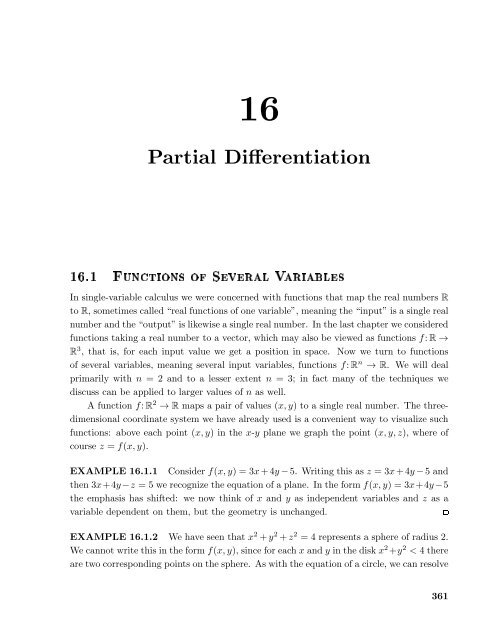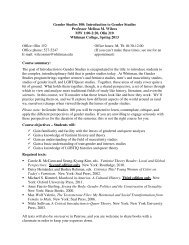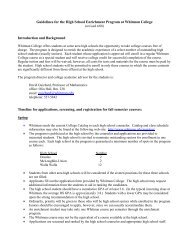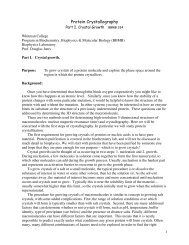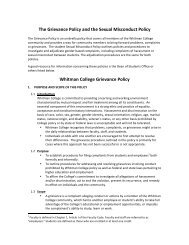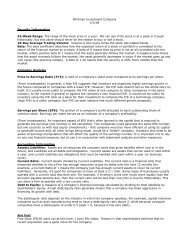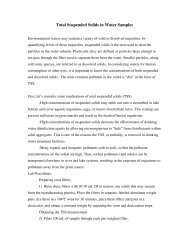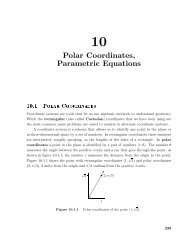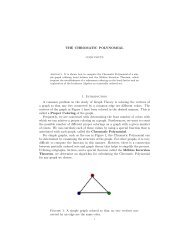Chapter 16 Partial Differentiation
Chapter 16 Partial Differentiation
Chapter 16 Partial Differentiation
Create successful ePaper yourself
Turn your PDF publications into a flip-book with our unique Google optimized e-Paper software.
½º¾ÄÑØ× Ò ÓÒØÒÙØÝ<strong>16</strong>.2 Limits and Continuity 365To develop calculus for functions of one variable, we needed to make sense of the concept ofa limit, which we needed to understand continuous functions and to define the derivative.Limits involving functions of two variables can be considerably more difficult to deal with;fortunately, most of the functions we encounter are fairly easy to understand.The potential difficulty is largely due to the fact that there are many ways to “approach”a point in the x-y plane. If we want to say thatlim(x,y)→(a,b)f(x,y) = L, we need tocapture the idea that as (x,y) gets close to (a,b) then f(x,y) gets close to L. For functionsof one variable, f(x), there are only two ways that x can approach a: from the left or right.But there are an infinite number of ways to approach (a,b): along any one of an infinitenumber of lines, or an infinite number of parabolas, or an infinite number of sine curves,and so on. We might hope that it’s really not so bad—suppose, for example, that alongevery possible line through (a,b) the value of f(x,y) gets close to L; surely this means that“f(x,y) approaches L as (x,y) approaches (a,b)”. Sadly, no.EXAMPLE <strong>16</strong>.2.1 Consider f(x,y) = xy 2 /(x 2 +y 4 ). When x = 0 or y = 0, f(x,y) is0, so the limit of f(x,y) approaching the origin along either the x or y axis is 0. Moreover,along the line y = mx, f(x,y) = m 2 x 3 /(x 2 + m 4 x 4 ). As x approaches 0 this expressionapproaches 0 as well. So along every line through the origin f(x,y) approaches 0. Nowsuppose we approach the origin along x = y 2 . Thenf(x,y) = y2 y 2y 4 +y 4 = y42y 4 = 1 2 ,so the limit is 1/2. Looking at figure <strong>16</strong>.2.1, it is apparent that there is a ridge abovex = y 2 . Approaching the origin along a straight line, we go over the ridge and then dropdown toward 0, but approaching along the ridge the height is a constant 1/2.Fortunately, we can define the concept of limit without needing to specify how aparticular point is approached—indeed, in definition 2.3.2, we didn’t need the concept of“approach.” Roughly, that definition says that when x is close to a then f(x) is close toL; there is no mention of “how” we get close to a. We can adapt that definition to twovariables quite easily:DEFINITION <strong>16</strong>.2.2 LimitSuppose f(x,y) is a function. We say thatlim f(x,y) = L(x,y)→(a,b)if for every ǫ > 0 there is a δ > 0 so that whenever 0 < √ (x−a) 2 +(y −b) 2 < δ,|f(x,y)−L| < ǫ.
366 <strong>Chapter</strong> <strong>16</strong> <strong>Partial</strong> <strong>Differentiation</strong>Figure <strong>16</strong>.2.1 f(x,y) = xy2x 2 +y 4 (AP)This says that we can make |f(x,y)−L| < ǫ, no matter how small ǫ is, by making thedistance from (x,y) to (a,b) “small enough”.EXAMPLE <strong>16</strong>.2.3 We show thatlim(x,y)→(0,0)∣ 3x 2 y ∣∣∣∣x 2 +y 2 = x2x 2 +y 23|y|.Note that x 2 /(x 2 +y 2 ) ≤ 1 and |y| = √ y 2 ≤ √ x 2 +y 2 < δ. Sox 2x 2 +y23|y| < 1·3·δ.3x 2 y= 0. Suppose ǫ > 0. Thenx 2 +y2
<strong>16</strong>.2 Limits and Continuity 367We want to force this to be less than ǫ by picking δ “small enough.” If we choose δ = ǫ/3then∣ ∣ ∣∣∣ 3x 2 y ∣∣∣< 1·3· ǫx 2 +y 2 3 = ǫ.Recall that a function f(x) is continuous at x = a if lim f(x) = f(a); roughly thisx→asays that there is no “hole” or “jump” at x = a. We can say exactly the same thing abouta function of two variables: f(x,y) is continuous at (a,b) iflim(x,y)→(a,b)f(x,y) = f(a,b).EXAMPLE <strong>16</strong>.2.4 The function f(x,y) = 3x 2 y/(x 2 +y 2 ) is not continuous at (0,0),because f(0,0) is not defined. However, we know that f(x,y) = 0, so we canlim(x,y)→(0,0)easily “fix” the problem, by extending the definition of f so that f(0,0) = 0. This surfaceis shown in figure <strong>16</strong>.2.2.-3-11.810.8-0.2-1.2-2.2-3-1133Figure <strong>16</strong>.2.2 f(x,y) = 3x2 yx 2 +y 2 (AP)Note that in contrast to this example we cannot fix example <strong>16</strong>.2.1 at (0,0) becausethe limit does not exist. No matter what value we try to assign to f at (0,0) the surfacewill have a “jump” there.
368 <strong>Chapter</strong> <strong>16</strong> <strong>Partial</strong> <strong>Differentiation</strong>Fortunately, the functions we will examine will typically be continuous almost everywhere.Usually this follows easily from the fact that closely related functions of onevariable are continuous. As with single variable functions, two classes of common functionsare particularly useful and easy to describe. A polynomial in two variables is a sum ofterms of the form ax m y n , where a is a real number and m and n are non-negative integers.A rational function is a quotient of polynomials.THEOREM <strong>16</strong>.2.5 Polynomials are continuous everywhere. Rational functions arecontinuous everywhere they are defined.Exercises <strong>16</strong>.2.Determine whether each limit exists. If it does, find the limit and prove that it is the limit; if itdoes not, explain how you know.1. lim(x,y)→(0,0)2. lim(x,y)→(0,0)3. lim(x,y)→(0,0)x 2x 2 +y ⇒ 2xyx 2 +y ⇒ 2xy2x 2 +y ⇒ 2x 4 −y 44. lim(x,y)→(0,0) x 2 +y ⇒ 2sin(x 2 +y 2 )5. lim(x,y)→(0,0) x 2 +y 26. lim(x,y)→(0,0)⇒xy√2x2 +y 2 ⇒e −x2 −y 2 −17. lim(x,y)→(0,0) x 2 +y 2x 3 +y 38. lim(x,y)→(0,0) x 2 +y ⇒ 2x 2 +sin 2 y9. lim ⇒(x,y)→(0,0) 2x 2 +y 2⇒(x−1) 2 lnx10. lim(x,y)→(1,0) (x−1) 2 +y ⇒ 211. lim(x,y)→(1,−1)3x+4y ⇒4x 2 y12. lim(x,y)→(0,0) x 2 +y ⇒ 213. Does the function f(x,y) = x−y1+x+yx−y1+x 2 +y2? Explain.have any discontinuities? What about f(x,y) =
½º¿ÈÖØÐ ÖÒØØÓÒ<strong>16</strong>.3 <strong>Partial</strong> <strong>Differentiation</strong> 369When we first considered what the derivative of a vector function might mean, there wasreally not much difficulty in understanding either how such a thing might be computed orwhat it might measure. In the case of functions of two variables, things are a bit harderto understand. If we think of a function of two variables in terms of its graph, a surface,there is a more-or-less obvious derivative-like question we might ask, namely, how “steep”is the surface. But it’s not clear that this has a simple answer, nor how we might proceed.We will start with what seem to be very small steps toward the goal; surprisingly, it turnsout that these simple ideas hold the keys to a more general understanding.86420−2−3−1−2 0x−1102132−3Figure <strong>16</strong>.3.1 f(x,y) = x 2 +y 2 , cut by the plane x+y = 1 (AP)Imagine a particular point on a surface; what might we be able to say about how steepit is? We can limit the question to make it more familiar: how steep is the surface in aparticular direction? What does this even mean? Here’s one way to think of it: Supposewe’re interested in the point (a,b,c). Pick a straight line in the x-y plane through thepoint (a,b,0), then extend the line vertically into a plane. Look at the intersection of theplane with the surface. If we pay attention to just the plane, we see the chosen straightline where the x-axis would normally be, and the intersection with the surface shows up asa curve in the plane. Figure <strong>16</strong>.3.1 shows the parabolic surface from figure <strong>16</strong>.1.2, exposingits cross-section above the line x+y = 1.
370 <strong>Chapter</strong> <strong>16</strong> <strong>Partial</strong> <strong>Differentiation</strong>In principle, this is a problem we know how to solve: find the slope of a curve in aplane. Let’s start by looking at some particularly easy lines: those parallel to the x or yaxis. Suppose we are interested in the cross-section of f(x,y) above the line y = b. If wesubstitute b for y in f(x,y), we get a function in one variable, describing the height of thecross-section as a function of x. Because y = b is parallel to the x-axis, if we view it froma vantage point on the negative y-axis, we will see what appears to be simply an ordinarycurve in the x-z plane.8.88.07.286.45.64.864.03.2z42−3−2−1 y0122.41.60.80.0−3−2−1012303210x−1−2−3Figure <strong>16</strong>.3.2 f(x,y) = x 2 +y 2 , cut by the plane y = 2 (AP)Consider again the parabolic surface f(x,y) = x 2 + y 2 . The cross-section above theline y = 2 consists of all points (x,2,x 2 +4). Looking at this cross-section from somewhereon the negative y axis, we see what appears to be just the curve f(x) = x 2 +4. At anypoint on the cross-section, (a,2,a 2 + 4), the steepness of the surface in the direction ofthe line y = 2 is simply the slope of the curve f(x) = x 2 + 4, namely 2x. Figure <strong>16</strong>.3.2shows the same parabolic surface as before, but now cut by the plane y = 2. The leftgraph shows the cut-off surface, the right shows just the cross-section, looking up from thenegative y-axis toward the origin.If, say, we’re interested in the point (−1,2,5) on the surface, then the slope in thedirection of the line y = 2 is 2x = 2(−1) = −2. This means that starting at (−1,2,5) andmoving on the surface, above the line y = 2, in the direction of increasing x values, the
<strong>16</strong>.3 <strong>Partial</strong> <strong>Differentiation</strong> 371surface goes down; of course moving in the opposite direction, toward decreasing x values,the surface will rise.If we’re interested in some other line y = k, there is really no change in the computation.The equation of the cross-section above y = k is x 2 +k 2 with derivative 2x. We cansave ourselves the effort, small as it is, of substituting k for y: all we are in effect doingis temporarily assuming that y is some constant. With this assumption, the derivativeddx (x2 +y 2 ) = 2x. To emphasize that we are only temporarily assuming y is constant, weuse a slightly different notation:∂∂x (x2 +y 2 ) = 2x; the “∂” reminds us that there are morevariables than x, but that only x is being treated as a variable. We read the equationas “the partial derivative of (x 2 + y 2 ) with respect to x is 2x.” A convenient alternatenotation for the partial derivative of f(x,y) with respect to x is is f x (x,y).EXAMPLE <strong>16</strong>.3.1 The partial derivative with respect to x of x 3 + 3xy is 3x 2 + 3y.Note that the partial derivative includes the variable y, unlike the example x 2 +y 2 . It issomewhat unusual for the partial derivative to depend on a single variable; this exampleis more typical.Of course, we can do the same sort of calculation for lines parallel to the y-axis. Wetemporarily hold x constant, which gives us the equation of the cross-section above a linex = k. We can then compute the derivative with respect to y; this will measure thesteepness of the curve in the y direction.EXAMPLE <strong>16</strong>.3.2 The partial derivative with respect to y of f(x,y) = sin(xy)+3xyisf y (x,y) = ∂ ∂y sin(xy)+3xy = cos(xy) ∂ (xy)+3x = xcos(xy)+3x.∂ySo far, using no new techniques, we have succeeded in measuring the slope of a surfacein two quite special directions. For functions of one variable, the derivative is closely linkedto the notion of tangent line. For surfaces, the analogous idea is the tangent plane—aplane that just touches a surface at a point, and has the same “steepness” as the surfacein all directions. Even though we haven’t yet figured out how to compute the slope inall directions, we have enough information to find tangent planes. Suppose we want theplane tangent to a surface at a particular point (a,b,c). If we compute the two partialderivatives of the function for that point, we get enough information to determine twolines tangent to the surface, both through (a,b,c) and both tangent to the surface in theirrespective directions. These two lines determine a plane, that is, there is exactly one planecontaining the two lines: the tangent plane. Figure <strong>16</strong>.3.3 shows (part of) two tangentlines at a point, and the tangent plane containing them.
372 <strong>Chapter</strong> <strong>16</strong> <strong>Partial</strong> <strong>Differentiation</strong>Figure <strong>16</strong>.3.3 Tangent vectors and tangent plane.How can we discover an equation for this tangent plane? We know a point on theplane, (a,b,c); we need a vector normal to the plane. If we can find two vectors, oneparallel to each of the tangent lines we know how to find, then the cross product of thesevectors will give the desired normal vector.3z.21..f x (2,b)00 1 2 3 4Figure <strong>16</strong>.3.4 A tangent vector.xHow can we find vectors parallel to the tangent lines? Consider first the line tangentto the surface above the line y = b. A vector 〈u,v,w〉 parallel to this tangent line musthave y component v = 0, and we may as well take the x component to be u = 1. The ratioof the z component to the x component is the slope of the tangent line, precisely what weknow how to compute. The slope of the tangent line is f x (a,b), sof x (a,b) = w u = w 1 = w.
<strong>16</strong>.3 <strong>Partial</strong> <strong>Differentiation</strong> 373In other words, a vector parallel to this tangent line is 〈1,0,f x (a,b)〉, as shown in figure<strong>16</strong>.3.4. If we repeat the reasoning for the tangent line above x = a, we get the vector〈0,1,f y (a,b)〉.Now to find the desired normal vector we compute the cross product, 〈0,1,f y 〉 ×〈1,0,f x 〉 = 〈f x ,f y ,−1〉. From our earlier discussion of planes, we can write down theequation we seek: f x (a,b)x + f y (a,b)y − z = k, and k as usual can be computed bysubstituting a known point: f x (a,b)(a)+f y (a,b)(b)−c = k. There are various more-orlessnice ways to write the result:f x (a,b)x+f y (a,b)y−z = f x (a,b)a+f y (a,b)b−cf x (a,b)x+f y (a,b)y−f x (a,b)a−f y (a,b)b+c = zf x (a,b)(x−a)+f y (a,b)(y−b)+c = zf x (a,b)(x−a)+f y (a,b)(y−b)+f(a,b) = zEXAMPLE <strong>16</strong>.3.3 Find the plane tangent to x 2 + y 2 + z 2 = 4 at (1,1, √ 2). Thispoint is on the upper hemisphere, so we use f(x,y) = √ 4−x 2 −y 2 . Then f x (x,y) =−x(4−x 2 −y 2 ) −1/2 and f y (x,y) = −y(4−x 2 −y 2 ) −1/2 , so f x (1,1) = f y (1,1) = −1/ √ 2and the equation of the plane isz = − 1 √2(x−1)− 1 √2(y −1)+ √ 2.The hemisphere and this tangent plane are pictured in figure <strong>16</strong>.3.3.So it appears that to find a tangent plane, we need only find two quite simple ordinaryderivatives, namely f x and f y . This is true if the tangent plane exists. It is, unfortunately,not always the case that if f x and f y exist there is a tangent plane. Consider the functionxy 2 /(x 2 + y 4 ) pictured in figure <strong>16</strong>.2.1. This function has value 0 when x = 0 or y = 0,and we can “plug the hole” by agreeing that f(0,0) = 0. Now it’s clear that f x (0,0) =f y (0,0) = 0, because in the x and y directions the surface is simply a horizontal line. Butit’s also clear from the picture that this surface does not have anything that deserves tobe called a “tangent plane” at the origin, certainly not the x-y plane containing these twotangent lines.When does a surface have a tangent plane at a particular point? What we really wantfrom a tangent plane, as from a tangent line, is that the plane be a “good” approximationof the surface near the point. Here is how we can make this precise:
374 <strong>Chapter</strong> <strong>16</strong> <strong>Partial</strong> <strong>Differentiation</strong>DEFINITION <strong>16</strong>.3.4 Let ∆x = x − x 0 , ∆y = y − y 0 , and ∆z = z − z 0 wherez 0 = f(x 0 ,y 0 ). The function z = f(x,y) is differentiable at (x 0 ,y 0 ) if∆z = f x (x 0 ,y 0 )∆x+f y (x 0 ,y 0 )∆y +ǫ 1 ∆x+ǫ 2 ∆y,and both ǫ 1 and ǫ 2 approach 0 as (x,y) approaches (x 0 ,y 0 ).This definition takes a bit of absorbing. Let’s rewrite the central equation a bit:z = f x (x 0 ,y 0 )(x−x 0 )+f y (x 0 ,y 0 )(y −y 0 )+f(x 0 ,y 0 )+ǫ 1 ∆x+ǫ 2 ∆y. (<strong>16</strong>.3.1)The first three terms on the right are the equation of the tangent plane, that is,f x (x 0 ,y 0 )(x−x 0 )+f y (x 0 ,y 0 )(y −y 0 )+f(x 0 ,y 0 )is the z-value of the point on the plane above (x,y). Equation <strong>16</strong>.3.1 says that the z-valueof a point on the surface is equal to the z-value of a point on the plane plus a “little bit,”namely ǫ 1 ∆x+ǫ 2 ∆y. As (x,y) approaches (x 0 ,y 0 ), both ∆x and ∆y approach 0, so thislittle bit ǫ 1 ∆x + ǫ 2 ∆y also approaches 0, and the z-values on the surface and the planeget close to each other. But that by itself is not very interesting: since the surface andthe plane both contain the point (x 0 ,y 0 ,z 0 ), the z values will approach z 0 and hence getclose to each other whether the tangent plane is “tangent” to the surface or not. The extracondition in the definition says that as (x,y) approaches (x 0 ,y 0 ), the ǫ values approach0—this means that ǫ 1 ∆x+ǫ 2 ∆y approaches 0 much, much faster, because ǫ 1 ∆x is muchsmaller than either ǫ 1 or ∆x. It is this extra condition that makes the plane a tangentplane.We can see that the extra condition on ǫ 1 and ǫ 2 is just what is needed if we look atpartial derivatives. Suppose we temporarily fix y = y 0 , so ∆y = 0. Then the equationfrom the definition becomesor∆z = f x (x 0 ,y 0 )∆x+ǫ 1 ∆x∆z∆x = f x(x 0 ,y 0 )+ǫ 1 .Now taking the limit of the two sides as ∆x approaches 0, the left side turns into thepartial derivative of z with respect to x at (x 0 ,y 0 ), or in other words f x (x 0 ,y 0 ), and theright side does the same, because as (x,y) approaches (x 0 ,y 0 ), ǫ 1 approaches 0. Essentiallythe same calculation works for f y .
<strong>16</strong>.4 The Chain Rule 375Exercises <strong>16</strong>.3.1. Find f x and f y where f(x,y) = cos(x 2 y)+y 3 . ⇒2. Find f x and f y where f(x,y) = xyx 2 +y . ⇒3. Find f x and f y where f(x,y) = e x2 +y 2 . ⇒4. Find f x and f y where f(x,y) = xyln(xy). ⇒5. Find f x and f y where f(x,y) = √ 1−x 2 −y 2 . ⇒6. Find f x and f y where f(x,y) = xtan(y). ⇒7. Find f x and f y where f(x,y) = 1xy . ⇒8. Find an equation for the plane tangent to 2x 2 +3y 2 −z 2 = 4 at (1,1,−1). ⇒9. Find an equation for the plane tangent to f(x,y) = sin(xy) at (π,1/2,1). ⇒10. Find an equation for the plane tangent to f(x,y) = x 2 +y 3 at (3,1,10). ⇒11. Find an equation for the plane tangent to f(x,y) = xln(xy) at (2,1/2,0). ⇒12. Find an equation for the line normal to x 2 +4y 2 = 2z at (2,1,4). ⇒13. Explain in your own words why, when taking a partial derivative of a function of multiplevariables, we can treat the variables not being differentiated as constants.14. Consider a differentiable function, f(x,y). Give physical interpretations of the meanings off x (a,b) and f y (a,b) as they relate to the graph of f.15. In much the same way that we used the tangent line to approximate the value of a functionfrom single variable calculus, we can use the tangent plane to approximate a function frommultivariable calculus. Consider the tangent plane found in Exercise 11. Use this plane toapproximate f(1.98,0.4).<strong>16</strong>. Suppose that one of your colleagues has calculated the partial derivatives of a given function,and reported to you that f x (x,y) = 2x + 3y and that f y (x,y) = 4x + 6y. Do you believethem? Why or why not? If not, what answer might you have accepted for f y ?17. Suppose f(t) and g(t) are single variable differentiable functions. Find ∂z/∂x and ∂z/∂y foreach of the following two variable functions.a. z = f(x)g(y)b. z = f(xy)c. z = f(x/y)½ºÌ Ò ÊÙÐConsider the surface z = x 2 y +xy 2 , and suppose that x = 2+t 4 and y = 1−t 3 . We canthink of the latter two equations as describing how x and y change relative to, say, time.Thenz = x 2 y +xy 2 = (2+t 4 ) 2 (1−t 3 )+(2+t 4 )(1−t 3 ) 2tells us explicitly how the z coordinate of the corresponding point on the surface dependson t. If we want to know dz/dt we can compute it more or less directly—it’s actually a bit
376 <strong>Chapter</strong> <strong>16</strong> <strong>Partial</strong> <strong>Differentiation</strong>simpler to use the chain rule:dzdt = x2 y ′ +2xx ′ y +x2yy ′ +x ′ y 2= (2xy +y 2 )x ′ +(x 2 +2xy)y ′= (2(2+t 4 )(1−t 3 )+(1−t 3 ) 2 )(4t 3 )+((2+t 4 ) 2 +2(2+t 4 )(1−t 3 ))(−3t 2 )If we look carefully at the middle step, dz/dt = (2xy+y 2 )x ′ +(x 2 +2xy)y ′ , we notice that2xy+y 2 is ∂z/∂x, and x 2 +2xy is ∂z/∂y. This turns out to be true in general, and givesus a new chain rule:THEOREM <strong>16</strong>.4.1 Suppose thatz = f(x,y),f isdifferentiable, x = g(t), andy = h(t).Assuming that the relevant derivatives exist,dzdt = ∂z dx∂x dt + ∂z dy∂y dt .Proof. If f is differentiable, then∆z = f x (x 0 ,y 0 )∆x+f y (x 0 ,y 0 )∆y +ǫ 1 ∆x+ǫ 2 ∆y,where ǫ 1 and ǫ 2 approach 0 as (x,y) approaches (x 0 ,y 0 ). Then∆z∆t = f ∆xx∆t +f ∆yy∆t +ǫ ∆x1∆t +ǫ ∆y2∆t . (<strong>16</strong>.4.1)As ∆t approaches 0, (x,y) approaches (x 0 ,y 0 ) and so∆zlim∆t→0 ∆t = dzdtlim∆t→0 ǫ 1lim∆t→0 ǫ 2∆x∆t∆y∆tdx= 0·dtdy= 0·dtand so taking the limit of (<strong>16</strong>.4.1) as ∆t goes to 0 givesas desired.dzdt = f dxxdt +f dyydt ,
<strong>16</strong>.4 The Chain Rule 377We can write the chain rule in way that is somewhat closer to the single variable chainrule:dfdt = 〈f x,f y 〉·〈x ′ ,y ′ 〉,or (roughly) the derivatives of the outside function “times” the derivatives of the insidefunctions. Not surprisingly, essentially the same chain rule works for functions of morethan two variables, for example, given a function of three variables f(x,y,z), where eachof x, y and z is a function of t,dfdt = 〈f x,f y ,f z 〉·〈x ′ ,y ′ ,z ′ 〉.We can even extend the idea further. Suppose that f(x,y) is a function and x = g(s,t)and y = h(s,t) are functions of two variables s and t. Then f is “really” a function of sand t as well, and∂f∂s = f xg s +f y h s∂f∂t = f xg t +f y h t .The natural extension of this to f(x,y,z) works as well.Recall that we used the ordinary chain rule to do implicit differentiation. We can dothe same with the new chain rule.EXAMPLE <strong>16</strong>.4.2 x 2 +y 2 +z 2 = 4 defines a sphere, which is not a function of x andy, though it can be thought of as two functions, the top and bottom hemispheres. Wecan think of z as one of these two functions, so really z = z(x,y), and we can think of xand y as particularly simple functions of x and y, and let f(x,y,z) = x 2 +y 2 +z 2 . Sincef(x,y,z) = 4, ∂f/∂x = 0, but using the chain rule:0 = ∂f∂x = f ∂xx∂x +f ∂yy∂x +f ∂zz∂x= (2x)(1)+(2y)(0)+(2z) ∂z∂x ,noting that since y is temporarily held constant its derivative ∂y/∂x = 0. Now we cansolve for ∂z/∂x:∂z∂x = −2x 2z = −x z .In a similar manner we can compute ∂z/∂y.
378 <strong>Chapter</strong> <strong>16</strong> <strong>Partial</strong> <strong>Differentiation</strong>Exercises <strong>16</strong>.4.1. Use the chain rule to compute dz/dt for z = sin(x 2 +y 2 ), x = t 2 +3, y = t 3 . ⇒2. Use the chain rule to compute dz/dt for z = x 2 y, x = sin(t), y = t 2 +1. ⇒3. Use the chain rule to compute ∂z/∂s and ∂z/∂t for z = x 2 y, x = sin(st), y = t 2 +s 2 . ⇒4. Use the chain rule to compute ∂z/∂s and ∂z/∂t for z = x 2 y 2 , x = st, y = t 2 −s 2 . ⇒5. Use the chain rule to compute ∂z/∂x and ∂z/∂y for 2x 2 +3y 2 −2z 2 = 9. ⇒6. Use the chain rule to compute ∂z/∂x and ∂z/∂y for 2x 2 +y 2 +z 2 = 9. ⇒7. Chemistry students will recognize the ideal gas law, given by PV = nRT which relates thePressure, Volume, and Temperature of n moles of gas. (R is the ideal gas constant). Thus,we can view pressure, volume, and temperature as variables, each one dependent on the othertwo.a. If pressure of a gas is increasing at a rate of 0.2Pa/min and temperature is increasing ata rate of 1K/min, how fast is the volume changing?b. If the volume of a gas is decreasing at a rate of 0.3L/min and temperature is increasingat a rate of .5K/min, how fast is the pressure changing?c. If the pressure of a gas is decreasing at a rate of 0.4Pa/min and the volume is increasingat a rate of 3L/min, how fast is the temperature changing?⇒8. Verify the following identity in the case of the ideal gas law:∂P∂V∂V∂T∂T∂P = −19. The previous exercise was a special case of the following fact, which you are to verify here:If F(x,y,z) is a function of 3 variables, and the relation F(x,y,z) = 0 defines each of thevariables in terms of the other two, namely x = f(y,z), y = g(x,z) and z = h(x,y), then∂x ∂y ∂z∂y ∂z ∂x = −1½ºÖØÓÒÐ ÖÚØÚ×We still have not answered one of our first questions about the steepness of a surface:starting at a point on a surface given by f(x,y), and walking in a particular direction, howsteep is the surface? We are now ready to answer the question.We already know roughly what has to be done: as shown in figure <strong>16</strong>.3.1, we extend aline in the x-y plane to a vertical plane, and we then compute the slope of the curve thatis the cross-section of the surface in that plane. The major stumbling block is that whatappears in this plane to be the horizontal axis, namely the line in the x-y plane, is not anactual axis—we know nothing about the “units” along the axis. Our goal is to make thisline into a t axis; then we need formulas to write x and y in terms of this new variable t;then we can write z in terms of t since we know z in terms of x and y; and finally we cansimply take the derivative.
<strong>16</strong>.5 Directional Derivatives 379So we need to somehow “mark off” units on the line, and we need a convenient wayto refer to the line in calculations. It turns out that we can accomplish both by using thevector form of a line. Suppose that u is a unit vector 〈u 1 ,u 2 〉 in the direction of interest. Avector equation for the line through (x 0 ,y 0 ) in this direction is v(t) = 〈u 1 t+x 0 ,u 2 t+y 0 〉.The height of the surface above the point (u 1 t+x 0 ,u 2 t+y 0 ) is g(t) = f(u 1 t+x 0 ,u 2 t+y 0 ).Because u is a unit vector, the value of t is precisely the distance along the line from(x 0 ,y 0 ) to (u 1 t+x 0 ,u 2 t+y 0 ); this means that the line is effectively a t axis, with originat the point (x 0 ,y 0 ), so the slope we seek isg ′ (0) = 〈f x (x 0 ,y 0 ),f y (x 0 ,y 0 )〉·〈u 1 ,u 2 〉= 〈f x ,f y 〉·u= ∇f ·uHerewehaveusedthechainruleandthederivatives d dt (u 1t+x 0 ) = u 1 and d dt (u 2t+y 0 ) = u 2 .The vector 〈f x ,f y 〉 is very useful, so it has its own symbol, ∇f, pronounced “del f”; it isalso called the gradient of f.EXAMPLE <strong>16</strong>.5.1 Find the slope of z = x 2 +y 2 at (1,2) in the direction of the vector〈3,4〉.We first compute the gradient at (1,2): ∇f = 〈2x,2y〉, which is 〈2,4〉 at (1,2). A unitvector in the desired direction is〈3/5,4/5〉, and the desired slope is then 〈2,4〉·〈3/5,4/5〉=6/5+<strong>16</strong>/5 = 22/5.EXAMPLE <strong>16</strong>.5.2 Find a tangent vector to z = x 2 +y 2 at (1,2) in the direction ofthe vector 〈3,4〉 and show that it is parallel to the tangent plane at that point.Since 〈3/5,4/5〉 is a unit vector in the desired direction, we can easily expand it to atangent vector simply by adding the third coordinate computed in the previous example:〈3/5,4/5,22/5〉. To see that this vector is parallel to the tangent plane, we can computeits dot product with a normal to the plane. We know that a normal to the tangent planeis〈f x (1,2),f y (1,2),−1〉 = 〈2,4,−1〉,and the dot product is 〈2,4,−1〉 · 〈3/5,4/5,22/5〉 = 6/5 + <strong>16</strong>/5 − 22/5 = 0, so the twovectorsareperpendicular. (Notethatthevectornormaltothesurface, namely〈f x ,f y ,−1〉,is simply the gradient with a −1 tacked on as the third component.)The slope of a surface given by z = f(x,y) in the direction of a (two-dimensional)vectoruiscalledthedirectional derivativeoff,writtenD u f. Thedirectionalderivative
380 <strong>Chapter</strong> <strong>16</strong> <strong>Partial</strong> <strong>Differentiation</strong>immediately provides us with some additional information. We know thatD u f = ∇f ·u = |∇f||u|cosθ = |∇f|cosθif u is a unit vector; θ is the angle between ∇f and u. This tells us immediately that thelargest value of D u f occurs when cosθ = 1, namely, when θ = 0, so ∇f is parallel to u.In other words, the gradient ∇f points in the direction of steepest ascent of the surface,and |∇f| is the slope in that direction. Likewise, the smallest value of D u f occurs whencosθ = −1, namely, when θ = π, so ∇f is anti-parallel to u. In other words, −∇f pointsin the direction of steepest descent of the surface, and −|∇f| is the slope in that direction.EXAMPLE <strong>16</strong>.5.3 Investigate the direction of steepest ascent and descent for z =x 2 +y 2 .The gradient is 〈2x,2y〉 = 2〈x,y〉; this is a vector parallel to the vector 〈x,y〉, so thedirection of steepest ascent is directly away from the origin, starting at the point (x,y).The direction of steepest descent is thus directly toward the origin from (x,y). Note thatat (0,0) the gradient vector is 〈0,0〉, which has no direction, and it is clear from the plotof this surface that there is a minimum point at the origin, and tangent vectors in alldirections are parallel to the x-y plane.If ∇f is perpendicular to u, D u f = |∇f|cos(π/2) = 0, since cos(π/2) = 0. This meansthat in either of the two directions perpendicular to ∇f, the slope of the surface is 0; thisimplies that a vector in either of these directions is tangent to the level curve at that point.Starting with ∇f = 〈f x ,f y 〉, it is easy to find a vector perpendicular to it: either 〈f y ,−f x 〉or 〈−f y ,f x 〉 will work.If f(x,y,z) is a function of three variables, all the calculations proceed in essentiallythe same way. The rate at which f changes in a particular direction is ∇f ·u, where now∇f = 〈f x ,f y ,f z 〉 and u = 〈u 1 ,u 2 ,u 3 〉 is a unit vector. Again ∇f points in the direction ofmaximum rate of increase, −∇f points in the direction of maximum rate of decrease, andany vector perpendicular to ∇f is tangent to the level surface f(x,y,z) = k at the pointin question. Of course there are no longer just two such vectors; the vectors perpendicularto ∇f describe the tangent plane to the level surface, or in other words ∇f is a normal tothe tangent plane.EXAMPLE <strong>16</strong>.5.4 Suppose the temperature at a point in space is given by T(x,y,z) =T 0 /(1+x 2 +y 2 +z 2 ); at the origin the temperature in Kelvin is T 0 > 0, and it decreases inevery direction from there. It might be, for example, that there is a source of heat at the
<strong>16</strong>.5 Directional Derivatives 381origin, and as we get farther from the source, the temperature decreases. The gradient is−2T 0 x∇T = 〈(1+x 2 +y 2 +z 2 ) 2 +=−2T 0(1+x 2 +y 2 +z 2 ) 2〈x,y,z〉.−2T 0 x(1+x 2 +y 2 +z 2 ) 2 +−2T 0 x(1+x 2 +y 2 +z 2 ) 2〉The gradient points directly at the origin from the point (x,y,z)—by moving directlytoward the heat source, we increase the temperature as quickly as possible.EXAMPLE <strong>16</strong>.5.5 Find the points on the surface defined by x 2 +2y 2 +3z 2 = 1 wherethe tangent plane is parallel to the plane defined by 3x−y +3z = 1.Two planes are parallel if their normals are parallel or anti-parallel, so we want tofind the points on the surface with normal parallel or anti-parallel to 〈3,−1,3〉. Let f =x 2 +2y 2 +3z 2 ; the gradient of f is normal to the level surface at every point, so we arelooking for a gradient parallel or anti-parallel to 〈3,−1,3〉. The gradient is 〈2x,4y,6z〉; ifit is parallel or anti-parallel to 〈3,−1,3〉, then〈2x,4y,6z〉 = k〈3,−1,3〉for some k. This means we need a solution to the equations2x = 3k 4y = −k 6z = 3kbut this is three equations in four unknowns—we need another equation. What we haven’tused so far is that the points we seek are on the surface x 2 + 2y 2 + 3z 2 = 1; this is thefourth equation. If we solve the first three equations for x, y, and z and substitute intothe fourth equation we get( ) 2 ( ) 2 ( 3k −k 3k1 = +2 +32 4 6( 9=4 + 2<strong>16</strong> + 3 )k 24= 258 k2(so k = ± 2√ 25 . The desired points are 3 √ √ √ ) (2 2 25 ,− 10 , and − 3√ √ √ )2 2 25 5 , 10 ,− . You5can see the surface and all three planes in the Java applet.) 2
382 <strong>Chapter</strong> <strong>16</strong> <strong>Partial</strong> <strong>Differentiation</strong>Exercises <strong>16</strong>.5.1. Find D u f for f = x 2 +xy +y 2 in the direction of u = 〈2,1〉 at the point (1,1). ⇒2. Find D u f for f = sin(xy) in the direction of u = 〈−1,1〉 at the point (3,1). ⇒3. Find D u f for f = e x cos(y) in the direction 30 degrees from the positive x axis at the point(1,π/4). ⇒4. The temperature of a thin plate in the x-y plane is T = x 2 +y 2 . How fast does temperaturechange at the point (1,5) moving in a direction 30 degrees from the positive x axis? ⇒5. Suppose the density of a thin plate at (x,y) is 1/ √ x 2 +y 2 +1. Find the rate of change ofthe density at (2,1) in a direction π/3 radians from the positive x axis. ⇒6. Suppose theelectricpotentialat(x,y) isln √ x 2 +y 2 . Findtherateof change ofthe potentialat (3,4) toward the origin and also in a direction at a right angle to the direction toward theorigin. ⇒7. A plane perpendicular to the x-y plane contains the point (2,1,8) on the paraboloid z =x 2 +4y 2 . The cross-section of the paraboloid created by this plane has slope 0 at this point.Find an equation of the plane. ⇒8. A plane perpendicular to the x-y plane contains the point (3,2,2) on the paraboloid 36z =4x 2 +9y 2 . The cross-section of the paraboloid created by this plane has slope 0 at this point.Find an equation of the plane. ⇒9. Suppose the temperature at (x,y,z) is given by T = xy +sin(yz). In what direction shouldyou go from the point (1,1,1) to decrease the temperature as quickly as possible? What isthe rate of change of temperature in this direction? ⇒10. Suppose the temperature at (x,y,z) is given by T = xyz. In what direction can you go fromthe point (1,1,1) to maintain the same temperature? ⇒11. Find an equation for the plane tangent to x 2 −3y 2 +z 2 = 7 at (1,1,3). ⇒12. Find an equation for the plane tangent to xyz = 6 at (1,2,3). ⇒13. Find an equation for the line normal to x 2 +2y 2 +4z 2 = 26 at (2,−3,−1). ⇒14. Find an equation for the line normal to x 2 +y 2 +9z 2 = 56 at (4,2,−2). ⇒15. Find an equation for the line normal to x 2 +5y 2 −z 2 = 0 at (4,2,6). ⇒<strong>16</strong>. Find the directions in which the directional derivative of f(x,y) = x 2 +sin(xy) at the point(1,0) has the value 1. ⇒17. Show that the curve r(t) = 〈ln(t),tln(t),t〉 is tangent to the surface xz 2 −yz +cos(xy) = 1at the point (0,0,1).18. A bug is crawling on the surface of a hot plate, the temperature of which at the point xunits to the right of the lower left corner and y units up from the lower left corner is givenby T(x,y) = 100−x 2 −3y 3 .a. If the bug is at the point (2,1), in what direction should it move to cool off the fastest?How fast will the temperature drop in this direction?b. If the bug is at the point (1,3), in what direction should it move in order to maintain itstemperature?⇒19. The elevation on a portion of a hill is given by f(x,y) = 100−4x 2 −2y. From the locationabove (2,1), in which direction will water run? ⇒
<strong>16</strong>.6 Higher order derivatives 38320. Suppose that g(x,y) = y−x 2 . Find the gradient at the point (−1,3). Sketch the level curveto the graph of g when g(x,y) = 2, and plot both the tangent line and the gradient vectorat the point (−1,3). (Make your sketch large). What do you notice, geometrically? ⇒21. The gradient ∇f is a vector valued function of two variables. Prove the following gradientrules. Assume f(x,y) and g(x,y) are differentiable functions.a. ∇(fg) = f∇(g)+g∇(f)b. ∇(f/g) = (g∇f −f∇g)/g 2c. ∇((f(x,y)) n ) = nf(x,y) n−1 ∇f½ºÀÖ ÓÖÖ ÖÚØÚ×In single variable calculus we saw that the second derivative is often useful: in appropriatecircumstances it measures acceleration; it can be used to identify maximum and minimumpoints; it tells us something about how sharply curved a graph is. Not surprisingly, secondderivatives are also useful in the multi-variable case, but again not surprisingly, things area bit more complicated.It’s easy to see where some complication is going to come from: with two variablesthere are four possible second derivatives. To take a “derivative,” we must take a partialderivative with respect to x or y, and there are four ways to do it: x then x, x then y, ythen x, y then y.EXAMPLE <strong>16</strong>.6.1 Compute all four second derivatives of f(x,y) = x 2 y 2 .Using an obvious notation, we get:f xx = 2y 2 f xy = 4xy f yx = 4xy f yy = 2x 2 .You will have noticed that two of these are the same, the “mixed partials” computedby taking partial derivatives with respect to both variables in the two possible orders. Thisis not an accident—as long as the function is reasonably nice, this will always be true.If the mixed partial derivatives are con-THEOREM <strong>16</strong>.6.2 Clairaut’s Theoremtinuous, they are equal.EXAMPLE <strong>16</strong>.6.3 Compute the mixed partials of f = xy/(x 2 +y 2 ).We leave f yx as an exercise.f x = y3 −x 2 yf(x 2 +y 2 ) 2 xy = − x4 −6x 2 y 2 +y 4(x 2 +y 2 ) 3
384 <strong>Chapter</strong> <strong>16</strong> <strong>Partial</strong> <strong>Differentiation</strong>Exercises <strong>16</strong>.6.1. Let f = xy/(x 2 +y 2 ); compute f xx , f yx , and f yy . ⇒2. Find all first and second partial derivatives of x 3 y 2 +y 5 . ⇒3. Find all first and second partial derivatives of 4x 3 +xy 2 +10. ⇒4. Find all first and second partial derivatives of xsiny. ⇒5. Find all first and second partial derivatives of sin(3x)cos(2y). ⇒6. Find all first and second partial derivatives of e x+y2 . ⇒7. Find all first and second partial derivatives of ln √ x 3 +y 4 . ⇒8. Findallfirstandsecond partialderivativesofz withrespecttoxandy ifx 2 +4y 2 +<strong>16</strong>z 2 −64 =0. ⇒9. Find all first and second partial derivatives of z with respect to x and y if xy+yz+xz = 1.⇒10. Let α and k be constants. Prove that the function u(x,t) = e −α2 k 2t sin(kx) is a solution tothe heat equation u t = α 2 u xx11. Let a be a constant. Prove that u = sin(x−at)+ln(x+at) is a solution to the wave equationu tt = a 2 u xx .12. How many third-order derivatives does a function of 2 variables have? How many of theseare distinct?13. How many nth order derivatives does a function of 2 variables have? How many of these aredistinct?½ºÅÜÑ Ò ÑÒÑSuppose a surface given by f(x,y) has a local maximum at (x 0 ,y 0 ,z 0 ); geometrically, thispoint on the surface looks like the top of a hill. If we look at the cross-section in theplane y = y 0 , we will see a local maximum on the curve at (x 0 ,z 0 ), and we know fromsingle-variable calculus that ∂z∂x = 0 at this point. Likewise, in the plane x = x 0, ∂z∂y = 0.So if there is a local maximum at (x 0 ,y 0 ,z 0 ), both partial derivatives at the point mustbe zero, and likewise for a local minimum. Thus, to find local maximum and minimumpoints, we need only consider those points at which both partial derivatives are 0. As inthe single-variable case, it is possible for the derivatives to be 0 at a point that is neithera maximum or a minimum, so we need to test these points further.You will recall that in the single variable case, we examined three methods to identifymaximum and minimum points; the most useful is the second derivative test, though itdoes not always work. For functions of two variables there is also a second derivative test;again it is by far the most useful test, though it doesn’t always work.THEOREM <strong>16</strong>.7.1 Suppose that the second partial derivatives of f(x,y) are continuousnear (x 0 ,y 0 ), and f x (x 0 ,y 0 ) = f y (x 0 ,y 0 ) = 0. We denote by D the discriminant
<strong>16</strong>.7 Maxima and minima 385D(x 0 ,y 0 ) = f xx (x 0 ,y 0 )f yy (x 0 ,y 0 ) − f xy (x 0 ,y 0 ) 2 . If D > 0 and f xx (x 0 ,y 0 ) < 0 there isa local maximum at (x 0 ,y 0 ); if D > 0 and f xx (x 0 ,y 0 ) > 0 there is a local minimum at(x 0 ,y 0 ); if D < 0 there is neither a maximum nor a minimum at (x 0 ,y 0 ); if D = 0, thetest fails.EXAMPLE <strong>16</strong>.7.2 Verify that f(x,y) = x 2 +y 2 has a minimum at (0,0).First, we compute all the needed derivatives:f x = 2x f y = 2y f xx = 2 f yy = 2 f xy = 0.The derivatives f x and f y are zero only at (0,0). Applying the second derivative test there:D(0,0) = f xx (0,0)f yy (0,0)−f xy (0,0) 2 = 2·2−0 = 4 > 0,so there is a local minimum at (0,0), and there are no other possibilities.EXAMPLE <strong>16</strong>.7.3 Find all local maxima and minima for f(x,y) = x 2 −y 2 .The derivatives:f x = 2x f y = −2y f xx = 2 f yy = −2 f xy = 0.Again there is a single critical point, at (0,0), andD(0,0) = f xx (0,0)f yy (0,0)−f xy (0,0) 2 = 2·−2−0 = −4 < 0,so there is neither a maximum nor minimum there, and so there are no local maxima orminima. The surface is shown in figure <strong>16</strong>.7.1.EXAMPLE <strong>16</strong>.7.4 Find all local maxima and minima for f(x,y) = x 4 +y 4 .The derivatives:f x = 4x 3 f y = 4y 3 f xx = 12x 2 f yy = 12y 2 f xy = 0.Again there is a single critical point, at (0,0), andD(0,0) = f xx (0,0)f yy (0,0)−f xy (0,0) 2 = 0·0−0 = 0,so we get no information. However, in this case it is easy to see that there is a minimumat (0,0), because f(0,0) = 0 and at all other points f(x,y) > 0.EXAMPLE <strong>16</strong>.7.5 Find all local maxima and minima for f(x,y) = x 3 +y 3 .
386 <strong>Chapter</strong> <strong>16</strong> <strong>Partial</strong> <strong>Differentiation</strong>7.55.02.50.0−5.0−2.5−2.5−5.00.0y5.02.50.0x−2.52.55.0−5.0Figure <strong>16</strong>.7.1 A saddle point, neither a maximum nor a minimum. (AP)The derivatives:f x = 3x 2 f y = 3y 2 f xx = 6x 2 f yy = 6y 2 f xy = 0.Again there is a single critical point, at (0,0), andD(0,0) = f xx (0,0)f yy (0,0)−f xy (0,0) 2 = 0·0−0 = 0,so we get no information. In this case, a little thought shows there is neither a maximumnor a minimum at (0,0): when x and y are both positive, f(x,y) > 0, and when x andy are both negative, f(x,y) < 0, and there are points of both kinds arbitrarily close to(0,0). Alternately, if we look at the cross-section when y = 0, we get f(x,0) = x 3 , whichdoes not have either a maximum or minimum at x = 0.EXAMPLE <strong>16</strong>.7.6 Suppose a box with no top is to hold a certain volume V. Find thedimensions for the box that result in the minimum surface area.The area of the box is A = 2hw + 2hl + lw, and the volume is V = lwh, so we canwrite the area as a function of two variables,A(l,w) = 2V l+ 2V w +lw.
<strong>16</strong>.7 Maxima and minima 387ThenA l = − 2Vl 2 +w and A w = − 2Vw 2 +l.If we set these equal to zero and solve, we find w = (2V) 1/3 and l = (2V) 1/3 , and thecorresponding height is h = V/(2V) 2/3 .The second derivatives areA ll = 4Vl 3A ww = 4Vw 3 A lw = 1,so the discriminant isD = 4V 4V−1 = 4−1 = 3 > 0.l 3 w3 Since A ll is 2, there is a local minimum at the critical point. Is this a global minimum?It is, but it is difficult to see this analytically; physically and graphically it is clear thatthere is a minimum, in which case it must be at the single critical point. Here is the graphas rendered by Sage, as an example. Note that we must choose a value for V in order tograph it.Recall that when we did single variable global maximum and minimum problems, theeasiest cases were those for which the variable could be limited to a finite closed interval,for then wesimply had to check allcritical valuesand the endpoints. The previous exampleis difficult because there is no finite boundary to the domain of the problem—both w andl can be in (0,∞). As in the single variable case, the problem is often simpler when thereis a finite boundary.THEOREM <strong>16</strong>.7.7 If f(x,y) is continuous on a closed and bounded subset of R 2 , thenit has both a maximum and minimum value.As in the case of singlevariable functions, this means that the maximum and minimumvalues must occur at a critical point or on the boundary; in the two variable case, however,the boundary is a curve, not merely two endpoints.EXAMPLE <strong>16</strong>.7.8 The length of the diagonal of a box is to be 1 meter; find themaximum possible volume.If the box is placed with one corner at the origin, and sides along the axes, the lengthof the diagonal is √ x 2 +y 2 +z 2 , and the volume isV = xyz = xy √ 1−x 2 −y 2 .
388 <strong>Chapter</strong> <strong>16</strong> <strong>Partial</strong> <strong>Differentiation</strong>Clearly, x 2 +y 2 ≤ 1, so the domain we are interested in is the quarter of the unit disk inthe first quadrant. Computing derivatives:V x = y −2yx2 −y 3√1−x2 −y 2V y = x−2xy2 −x 3√1−x2 −y 2If these are both 0, then x = 0 or y = 0, or x = y = 1/ √ 3. The boundary of the domain iscomposed of three curves: x = 0 for y ∈ [0,1]; y = 0 for x ∈ [0,1]; and x 2 +y 2 = 1, wherex ≥ 0 and y ≥ 0. In all three cases, the volume xy √ 1−x 2 −y 2 is 0, so the maximumoccurs at the only critical point (1/ √ 3,1/ √ 3,1/ √ 3). See figure <strong>16</strong>.7.2.0.00.250.50.150.750.10.050.00.00.250.50.751.01.0Figure <strong>16</strong>.7.2 The volume of a box with fixed length diagonal.Exercises <strong>16</strong>.7.1. Find all local maximum and minimum points of f = x 2 +4y 2 −2x+8y −1. ⇒2. Find all local maximum and minimum points of f = x 2 −y 2 +6x−10y +2. ⇒3. Find all local maximum and minimum points of f = xy. ⇒4. Find all local maximum and minimum points of f = 9+4x−y −2x 2 −3y 2 . ⇒5. Find all local maximum and minimum points of f = x 2 +4xy +y 2 −6y +1. ⇒
<strong>16</strong>.8 Lagrange Multipliers 3896. Find all local maximum and minimum points of f = x 2 −xy +2y 2 −5x+6y −9. ⇒7. Find the absolute maximum and minimum points of f = x 2 + 3y − 3xy over the regionbounded by y = x, y = 0, and x = 2. ⇒8. A six-sided rectangular box is to hold 1/2 cubic meter; what shape should the box be tominimize surface area? ⇒9. The post office will accept packages whose combined length and girth is at most 130 inches.(Girth is the maximum distance around the package perpendicular to the length; for a rectangularbox, the length is the largest of the three dimensions.) What is the largest volumethat can be sent in a rectangular box? ⇒10. The bottom of a rectangular box costs twice as much per unit area as the sides and top.Find the shape for a given volume that will minimize cost. ⇒11. Using the methods of this section, find the shortest distance from the origin to the planex+y +z = 10. ⇒12. Using the methods of this section, find the shortest distance from the point (x 0 ,y 0 ,z 0 ) tothe plane ax+by +cz = d. You may assume that c ≠ 0; use of Sage or similar software isrecommended. ⇒13. A trough is to be formed by bending up two sides of a long metal rectangle so that thecross-section of the trough is an isosceles trapezoid, as in figure 6.2.6. If the width of themetal sheet is 2 meters, how should it be bent to maximize the volume of the trough? ⇒14. Given the three points (1,4), (5,2), and (3,−2), (x−1) 2 +(y −4) 2 +(x−5) 2 +(y −2) 2 +(x−3) 2 +(y +2) 2 is the sum of the squares of the distances from point (x,y) to the threepoints. Find x and y so that this quantity is minimized. ⇒15. Suppose that f(x,y) = x 2 +y 2 +kxy. Find and classify the critical points, and discuss howthey change when k takes on different values.<strong>16</strong>. Find the shortest distance from the point (0,b) to the parabola y = x 2 . ⇒17. Find the shortest distance from the point (0,0,b) to the paraboloid z = x 2 +y 2 . ⇒18. Consider the function f(x,y) = x 3 −3x 2 y +y 3 .a. Show that (0,0) is the only critical point of f.b. Show that the discriminant test is inconclusive for f.c. Determine the cross-sections of f obtained by setting y = kx for various values of k.d. What kind of critical point is (0,0)?19. Find the volume of the largest rectangular box with edges parallel to the axes that can beinscribed in the ellipsoid 2x 2 +72y 2 +18z 2 = 288. ⇒½ºÄÖÒ ÅÙÐØÔÐÖ×Many applied max/min problems take the form of the last two examples: we want tofind an extreme value of a function, like V = xyz, subject to a constraint, like 1 =√x2 +y 2 +z 2 . Often this can be done, as we have, by explicitly combining the equationsand then finding critical points. There is another approach that is often convenient, themethod of Lagrange multipliers.
390 <strong>Chapter</strong> <strong>16</strong> <strong>Partial</strong> <strong>Differentiation</strong>It is somewhat easier to understand two variable problems, so we begin with one asan example. Suppose the perimeter of a rectangle is to be 100 units. Find the rectanglewith largest area. This is a fairly straightforward problem from single variable calculus.We write down the two equations: A = xy, P = 100 = 2x + 2y, solve the second ofthese for y (or x), substitute into the first, and end up with a one-variable maximizationproblem. Let’s now think of it differently: the equation A = xy defines a surface, and theequation 100 = 2x+2y defines a curve (a line, in this case) in the x-y plane. If we graphboth of these in the three-dimensional coordinate system, we can phrase the problem likethis: what is the highest point on the surface above the line? The solution we alreadyunderstand effectively produces the equation of the cross-section of the surface above theline and then treats it as a single variable problem. Instead, imagine that we draw thelevel curves (the contour lines) for the surface in the x-y plane, along with the line.5040y302010001020 30 40 50xFigure <strong>16</strong>.8.1 Constraint line with contour plot of the surface xy.Imagine that the line represents a hiking trail and the contour lines are, as on atopographic map, the lines of constant altitude. How could you estimate, based on thegraph, the high (or low) points on the path? As the path crosses contour lines, you knowthe path must be increasing or decreasing in elevation. At some point you will see the pathjust touch a contour line (tangent to it), and then begin to cross contours in the oppositeorder—that point of tangency must be a maximum or minimum point. If we can identifyall such points, we can then check them to see which gives the maximum and which theminimum value. As usual, we also need to check boundary points; in this problem, weknow that x and y are positive, so we are interested in just the portion of the line in thefirst quadrant, as shown. The endpoints of the path, the two points on the axes, are not
<strong>16</strong>.8 Lagrange Multipliers 391points of tangency, but they are the two places that the function xy is a minimum in thefirst quadrant.How can we actually make use of this? At the points of tangency that we seek, theconstraint curve (in this case the line) and the level curve have the same slope—theirtangent lines are parallel. This also means that the constraint curve is perpendicular tothe gradient vector of the function; going a bit further, if we can express the constraintcurve itself as a level curve, then we seek the points at which the two level curves haveparallel gradients. The curve 100 = 2x + 2y can be thought of as a level curve of thefunction 2x+2y; figure <strong>16</strong>.8.2 shows both sets of level curves on a single graph. We areinterested in those points where two level curves are tangent—but there are many suchpoints, in fact an infinite number, as we’ve only shown a few of the level curves. All alongthe line y = x are points at which two level curves are tangent. While this might seem tobe a show-stopper, it is not.5040y302010001020x30 4050Figure <strong>16</strong>.8.2 Contour plots for 2x+2y and xy.The gradient of 2x + 2y is 〈2,2〉, and the gradient of xy is 〈y,x〉. They are parallelwhen 〈2,2〉 = λ〈y,x〉, that is, when 2 = λy and 2 = λx. We have two equations in threeunknowns, whichtypicallyresultsinmanysolutions(asweexpected). Athirdequationwillreduce the number of solutions; the third equation is the original constraint, 100 = 2x+2y.So we have the following system to solve:2 = λy 2 = λx 100 = 2x+2y.
392 <strong>Chapter</strong> <strong>16</strong> <strong>Partial</strong> <strong>Differentiation</strong>In the first two equations, λ can’t be 0, so we may divide by it to get x = y = 2/λ.Substituting into the third equation we get2 2 λ +22 λ = 1008100 = λso x = y = 25. Note that we are not really interested in the value of λ—it is a clevertool, the Lagrange multiplier, introduced to solve the problem. In many cases, as here, itis easier to find λ than to find everything else without using λ.The same method works for functions of three variables, except of course everythingis one dimension higher: the function to be optimized is a function of three variables andthe constraint represents a surface—for example, the function may represent temperature,and we may be interested in the maximum temperature on some surface, like a sphere.The points we seek are those at which the constraint surface is tangent to a level surface ofthe function. Once again, we consider the constraint surface to be a level surface of somefunction, and we look for points at which the two gradients are parallel, giving us threeequations in four unknowns. The constraint provides a fourth equation.EXAMPLE <strong>16</strong>.8.1 Recall example <strong>16</strong>.7.8: the diagonal of a box is 1, we seek tomaximize the volume. The constraint is 1 = √ x 2 +y 2 +z 2 , which is the same as 1 =x 2 +y 2 +z 2 . The function to maximize is xyz. The two gradient vectors are 〈2x,2y,2z〉and 〈yz,xz,xy〉, so the equations to be solved areyz = 2xλxz = 2yλxy = 2zλ1 = x 2 +y 2 +z 2If λ = 0 then at least two of x, y, z must be 0, giving a volume of 0, which will not be themaximum. If we multiply the first two equations by x and y respectively, we getxyz = 2x 2 λxyz = 2y 2 λso 2x 2 λ = 2y 2 λ or x 2 = y 2 ; in the same way we can show x 2 = z 2 . Hence the fourthequation becomes 1 = x 2 + x 2 + x 2 or x = 1/ √ 3, and so x = y = z = 1/ √ 3 gives themaximum volume. This is of course the same answer we obtained previously.
<strong>16</strong>.8 Lagrange Multipliers 393Another possibility is that we have a function of three variables, and we want tofind a maximum or minimum value not on a surface but on a curve; often the curveis the intersection of two surfaces, so that we really have two constraint equations, sayg(x,y,z) = c 1 and h(x,y,z) = c 2 . It turns out that at points on the intersection of thesurfaces where f has a maximum or minimum value,∇f = λ∇g +µ∇h.As before, this gives us three equations, one for each component of the vectors, but nowin five unknowns, x, y, z, λ, and µ. Since there are two constraint functions, we have atotal of five equations in five unknowns, and so can usually find the solutions we need.EXAMPLE <strong>16</strong>.8.2 The plane x+y −z = 1 intersects the cylinder x 2 +y 2 = 1 in anellipse. Find the points on the ellipse closest to and farthest from the origin.We want the extreme values of f = √ x 2 +y 2 +z 2 subject to the constraints g =x 2 + y 2 = 1 and h = x + y − z = 1. To simplify the algebra, we may use insteadf = x 2 + y 2 + z 2 , since this has a maximum or minimum value at exactly the points atwhich √ x 2 +y 2 +z 2 does. The gradients are∇f = 〈2x,2y,2z〉 ∇g = 〈2x,2y,0〉 ∇h = 〈1,1,−1〉,so the equations we need to solve are2x = λ2x+µ2y = λ2y +µ2z = 0−µ1 = x 2 +y 21 = x+y −z.Subtracting the first two we get 2y −2x = λ(2y −2x), so either λ = 1 or x = y. If λ = 1then µ = 0, so z = 0 and the last two equations are1 = x 2 +y 2 and 1 = x+y.Solving these gives x = 1, y = 0, or x = 0, y = 1, so the points of interest are (1,0,0)and (0,1,0), which are both distance 1 from the origin. If x = y, the fourth equation is2x 2 = 1, giving x = y = ±1/ √ 2, and from the fifth equation we get z = −1 ± √ 2. Thedistance from the origin to (1/ √ 2,1/ √ 2,−1+ √ 2) is √ 4−2 √ 2 ≈ 1.08 and the distancefrom the origin to (−1/ √ 2,−1/ √ 2,−1− √ 2) is √ 4+2 √ 2 ≈ 2.6. Thus, the points (1,0,0)and (0,1,0) are closest to the origin and (−1/ √ 2,−1/ √ 2,−1 − √ 2) is farthest from theorigin. The Java applet shows the cylinder, the plane, the four points of interest, and theorigin.
394 <strong>Chapter</strong> <strong>16</strong> <strong>Partial</strong> <strong>Differentiation</strong>Exercises <strong>16</strong>.8.1. A six-sided rectangular box is to hold 1/2 cubic meter; what shape should the box be tominimize surface area? ⇒2. The post office will accept packages whose combined length and girth are at most 130 inches(girth is the maximum distance around the package perpendicular to the length). What isthe largest volume that can be sent in a rectangular box? ⇒3. The bottom of a rectangular box costs twice as much per unit area as the sides and top.Find the shape for a given volume that will minimize cost. ⇒4. Using Lagrange multipliers, find the shortest distance from the point (x 0 ,y 0 ,z 0 ) to the planeax+by +cz = d. ⇒5. Find all points on the surface xy −z 2 +1 = 0 that are closest to the origin. ⇒6. The material for the bottom of an aquarium costs half as much as the high strength glass forthe four sides. Find the shape of the cheapest aquarium that holds a given volume V. ⇒7. The plane x−y+z = 2 intersects the cylinder x 2 +y 2 = 4 in an ellipse. Find the points onthe ellipse closest to and farthest from the origin. ⇒8. Find three positive numbers whose sum is 48 and whose product is as large as possible. ⇒9. Find all points on the plane x+y+z = 5 in the first octant at which f(x,y,z) = xy 2 z 2 hasa maximum value. ⇒10. Find the points on the surface x 2 −yz = 5 that are closest to the origin. ⇒11. A manufacturer makes two models of an item, standard and deluxe. It costs $40 to manufacturethe standard model and $60 for the deluxe. A market research firm estimates that ifthe standard model is priced at x dollars and the deluxe at y dollars, then the manufacturerwill sell 500(y −x) of the standard items and 45,000+500(x−2y) of the deluxe each year.How should the items be priced to maximize profit? ⇒12. A length of sheet metal is to be made into a water trough by bending up two sides as shownin figure <strong>16</strong>.8.3. Find x and φ so that the trapezoid–shaped cross section has maximum area,when the width of the metal sheet is 27 inches (that is, 2x+y = 27). ⇒φx.yx.φ.Figure <strong>16</strong>.8.3 Cross-section of a trough.13. Find the maximum and minimum values of f(x,y,z) = 6x+3y+2z subject to the constraintg(x,y,z) = 4x 2 +2y 2 +z 2 −70 = 0. ⇒14. Find the maximum and minimum values of f(x,y) = e xy subject to the constraint g(x,y) =x 3 +y 3 −<strong>16</strong> = 0. ⇒15. Find the maximum and minimum values of f(x,y) = xy + √ 9−x 2 −y 2 when x 2 +y 2 ≤ 9.⇒<strong>16</strong>. Find three real numbers whose sum is 9 and the sum of whose squares is a small as possible.⇒17. Find the dimensions of the closed rectangular box with maximum volume that can be inscribedin the unit sphere. ⇒


